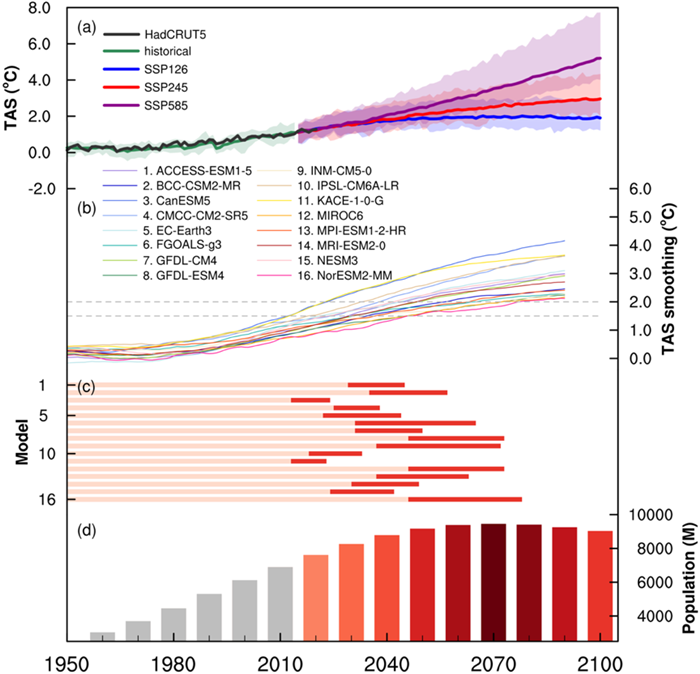政府间气候变化专门委员会(IPCC)第六次评估报告(AR6)指出相对于工业革命前,全球变暖背景下极端气候事件发生更为频繁。由极端事件引发的气象灾害及衍生灾害导致的损失不断增加,灾害风险不断加大,严重影响社会、经济和人类生活等方面,引起广泛关注(Qin and Xie, 2016, 2017)。《巴黎协定》提出本世纪末将全球温度升高保持在相对于工业化革命前水平2.0℃以内,并为温度升高控制在1.5℃以内努力。
最近,中国科学院大气物理研究所秦佩华及合作者研究了全球变暖停滞期中国极端气候的变化(Qin and Shi, 2022),量化了未来气温每升高1℃时极端气候的变化(Qin et al., 2021)。灾害风险受自然过程及人口的共同影响,为了更好预估极端事件对人类社会的影响,人口时空分布必须要考虑。作者利用参与第六次耦合模式比较计划(CMIP6)的模式模拟结果(图1),研究了极端气候事件人口暴露度变化,采用的是来自ETCCTI的4个极端事件指标:夏日日数(SU)、霜冻日数(FD)、连续降水日数(CWD)及连续干旱日数(CDD)。在中部非洲(WCEAF)、阿拉伯半岛(ARP)、南亚(SAS)地区,CWD,CDD及SU的人口暴露度在1.5℃及2.0℃全球变暖情景下明显增加,而在东亚地区(EAS)明显减少,这主要是由于EAS未来人口减少导致的。
我们还发现全球温度升高1.5℃和2.0℃,以及从1.5℃升温到2.0℃,经历4个极端事件人口暴露度均增加的人口分别为23.58亿、19.00亿和15.69亿。除冷极端事件FD外,经历其他三个极端事件人口暴露度增加的人口分别为72.42亿、65.74亿和62.99亿,超过全球2/3的人口总数(图2)。因此,全球变暖下,我们可能面对更为严峻的气候风险。
该研究成果已被《Atmospheric Research》接受并在线发表。
参考文献
1.Qin, P. H. (2022) More than six billion people encountering more exposure to extremes with 1.5°C and 2.0°C warming. Atmos. Res. Accepted. https://doi.org/10.1016/j.atmosres.2022.106165
2.Qin, P. H., C. X. Shi (2022). Characteristics of climate extremes in China during the recent global warming hiatus based upon machine learning. Int. J. Climatol., 42(4), 2099– 2116. https://doi.org/10.1002/joc.7354
3.Qin, P. H., Z. H. Xie, J. Zou, S. Liu, S. Chen (2021) Future Precipitation Extremes in China under Climate Change and Their Physical Quantification Based on a Regional Climate Model and CMIP5 Model Simulations. Adv. Atmos. Sci. 38, 460–479. https://doi.org/10.1007/s00376-020-0141-4
4.Qin, P. H., and Z. H. Xie (2017) Precipitation extremes in the dry and wet regions of China and their connections with the sea surface temperature in the eastern tropical Pacific Ocean, J. Geophys. Res. Atmos., 122, 6273– 6283. https://doi.org/10.1002/2016JD026242
5.Qin, P. H., and Z. H. Xie (2016) Detecting changes in future precipitation extremes over eight river basins in China using RegCM4 downscaling, J. Geophys. Res. Atmos., 121, 6802– 6821. https://doi.org/10.1002/2016JD024776

图1. 过去及未来不同共享社会经济路径下全球气温变化(a, b)。(c) 是全球温度升高1.5°C及2.0°C时的年份,(d)是过去及未来全球人口变化。

图2. 全球温度升高1.5℃、2.0℃及从1.5℃升温到2.0℃时,极端气候事件人口暴露度增加的复合指数空间分布及相应人口统计,其中复合指数15表示4个极端事件人口暴露度均增加,13表示除了霜冻日数FD外,其他3个极端事件人口暴露度均增加。






